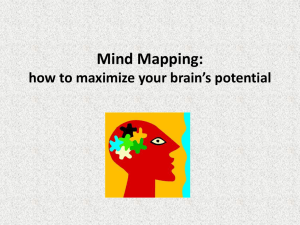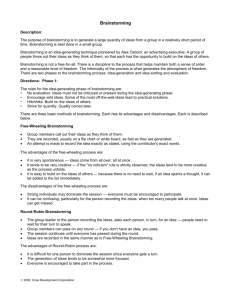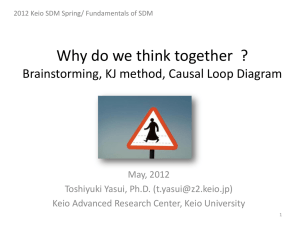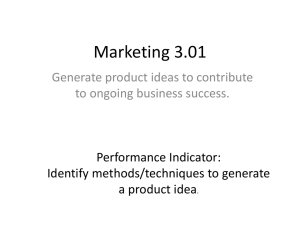Case Study - Christianeducationnetwork.org
advertisement
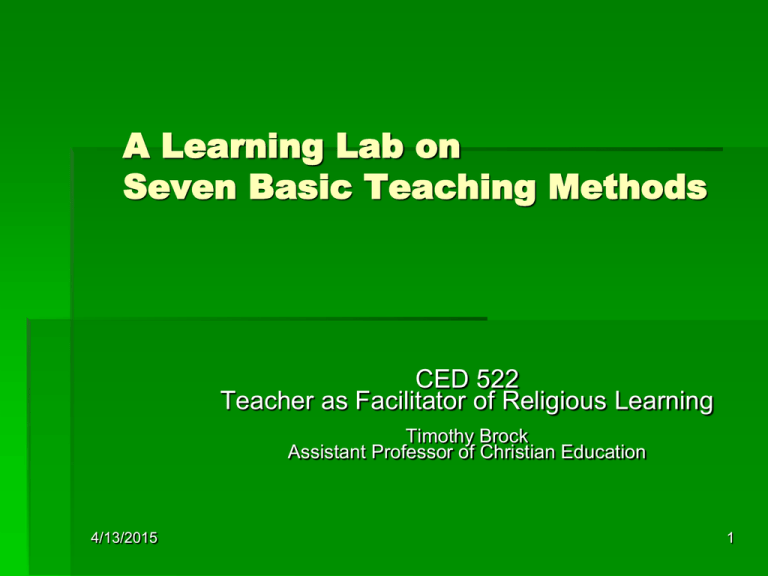
A Learning Lab on Seven Basic Teaching Methods CED 522 Teacher as Facilitator of Religious Learning Timothy Brock Assistant Professor of Christian Education 4/13/2015 1 Introduction to the Learning Lab The learning lab will include an overview of seven basic teaching methods. Participants will develop skills in matching teaching methods to learning objectives. Many of the seven basic methods will be modeled during the training. 4/13/2015 2 Overview: The Basic 7 Lecture Question and Answer Group Discussion Case Study Brainstorming Projects Storytelling 4/13/2015 3 Overview: The Basic 7+ Lecture—with demonstration Question and Answer—content, opinion, attitudes, or emotions Group Discussion—with small group options Case Study—with movies and role play Brainstorming—with inductive Q and A Projects—research or action Storytelling—contemporary parables 4/13/2015 4 Goal In the next 45 minutes, you will add to your repertoire of teaching methods. Lecture Answers Question s Discussio n Stor y 4/13/2015 Projects Brainstor m Case Study 5 Lecture A lecture is a speech by one speaker before an audience. Use a lecture when: Giving information… The learners are already motivated… You are skilled in using word pictures… The group is too large for other methods… Reviewing or previewing a lesson… 4/13/2015 6 Lecture Advantages of a Lecture… Disadvantages of a Lecture… Use a lecture in combination with another method (demonstration) 4/13/2015 7 Question and Answer--Q/A The question and answer method is a series of queries and responses designed to test comprehension of a body of material and understanding one’s reaction to it. Use Q/A when: Reviewing information… Soliciting opinions… Assessing attitudes… Gauging emotions… 4/13/2015 8 Question and Answer--Q/A Advantages of Q/A Disadvantages of Q/A Q/A is often used in combination with other methods. 4/13/2015 9 Group Discussion Group discussion is a planned conversation between three or more persons on a selected topic, with leadership. Use group discussion: When sharing ideas… To stimulate interest in problem… To help members express their ideas… To identify and explore a problem… To create an informal atmosphere… 4/13/2015 10 Group Discussion Advantages of Group Discussion Disadvantages of Group Discussion One alternative to a group discussion is small study groups. These groups are assigned a problem, allowed to discuss the problem, and expected to report back to the large group. 4/13/2015 11 Case Study A Case Study is an account of a problem situation, including sufficient detail to make it possible for groups to analyze problems involved. The case is a “slice of life” that invites diagnosis, prescription, and possible treatment. It may be presented in writing, orally, dramatically, on film, or as a recording. 4/13/2015 12 Case Study Use a case study when: Relating a problem to life situations… Analyzing a problem… To help members identify with a problem… A number of possible solutions may be appropriate… Analyzing the bearing of facts and opinions upon a problem… 4/13/2015 13 Case Study Advantages of a Case Study Disadvantages of a Case Study Current movies or music may be used as the content of the case study. If your group is open to creative approaches, role play may also be used. 4/13/2015 14 Brainstorming Brainstorming is a method of problem solving in which group members suggest in rapid fire order all the possible solutions they can think of. Criticism is ruled out. Evaluation of ideas comes later. 4/13/2015 15 Brainstorming Use brainstorming: To encourage creative thinking… To encourage participation… When determining possible solutions to problems… To encourage presentation of new ideas… To create a warm, friendly feeling in the group… 4/13/2015 16 Brainstorming Advantages of Brainstorming Disadvantages of Brainstorming Using inductive questions and answers, brainstorming can lead the class to develop and express principles and values. 4/13/2015 17 Projects Projects are “homework”—activities to be conducted outside the classroom, between class meetings. Use group discussion: To encourage participants to develop skills in biblical exegesis … To encourage participants to research a biblical concept, image, or a word… To challenge participants to apply biblical truth in “real life contexts” … To nurture Christian attitudes and actions… 4/13/2015 18 Storytelling Storytelling is the art of orally sharing “contemporary parables”—vignettes from “everyday life” which point to deeper life truths. Use storytelling: To encourage the learner to relate biblical truths to life situations… To inspire and to motivate learners… To stimulate the creativity of the learner… To allow learners to draw their our conclusions about the truth of the story … 4/13/2015 19 Summary In this learning lab, we have overviewed seven basic teaching methods. You have developed some skills in matching teaching methods to learning objectives. You have seen some of the seven basic methods modeled during the training. 4/13/2015 20 Assignment: A Project Prior to your next teaching experience, select one of the seven teaching methods overviewed during this training. Please pick one of the methods with which you have little knowledge or experience. Based on our work today, use this teaching method. Next, select another person who participated in this training to be your partner. After your class, evaluate your experience of using this new teaching method with your partner. 4/13/2015 21



